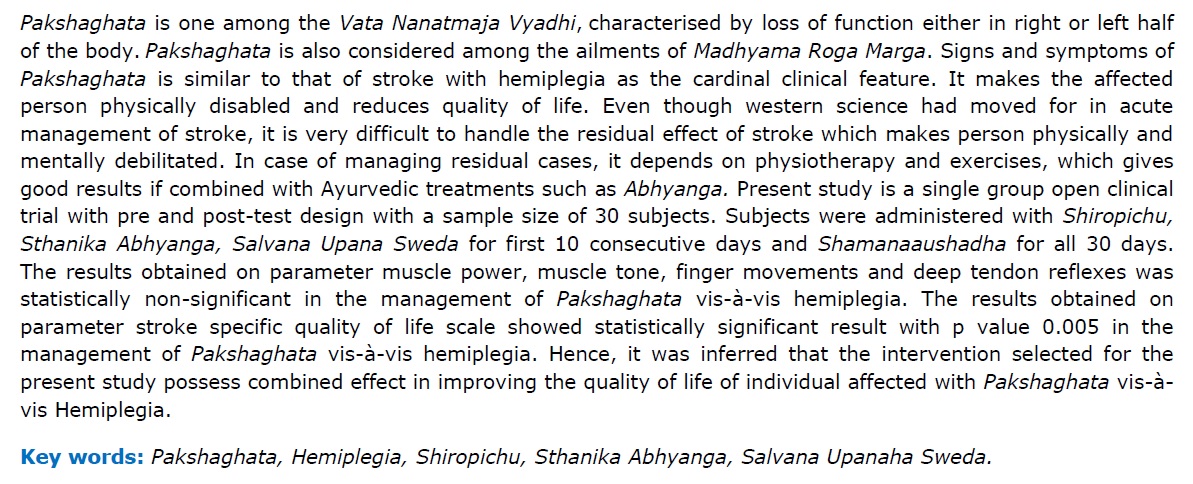An explorative clinical study to evaluate the combined effect of Shiropichu, Sthanika Abhyanga, Salvana Upanaha Sweda and Balarishta in the management of Pakshaghata vis~a~vis Hemiplegia
DOI:
https://doi.org/10.21760/jaims.v6i5.1458Keywords:
Pakshaghata, Hemiplegia, Shiropichu, Sthanika Abhyanga, Salvana Upanaha Sweda.Abstract
Pakshaghata is one among the Vata Nanatmaja Vyadhi, characterised by loss of function either in right or left half of the body. Pakshaghata is also considered among the ailments of Madhyama Roga Marga. Signs and symptoms of Pakshaghata is similar to that of stroke with hemiplegia as the cardinal clinical feature. It makes the affected person physically disabled and reduces quality of life. Even though western science had moved for in acute management of stroke, it is very difficult to handle the residual effect of stroke which makes person physically and mentally debilitated. In case of managing residual cases, it depends on physiotherapy and exercises, which gives good results if combined with Ayurvedic treatments such as Abhyanga. Present study is a single group open clinical trial with pre and post-test design with a sample size of 30 subjects. Subjects were administered with Shiropichu, Sthanika Abhyanga, Salvana Upana Sweda for first 10 consecutive days and Shamanaaushadha for all 30 days. The results obtained on parameter muscle power, muscle tone, finger movements and deep tendon reflexes was statistically non-significant in the management of Pakshaghata vis-à-vis hemiplegia. The results obtained on parameter stroke specific quality of life scale showed statistically significant result with p value 0.005 in the management of Pakshaghata vis-à-vis hemiplegia. Hence, it was inferred that the intervention selected for the present study possess combined effect in improving the quality of life of individual affected with Pakshaghata vis-à-vis Hemiplegia.
Downloads
References
Agnivesha, Charaka samhita, chikitsha sthana, 28th chapter, shloka no.53-55, Chakrapanidatta Virachita, edited by Yadavji Trikamaji Acharya, Varanasi, Chaukhambha Sanskrit Sansthan, 2014, pg no-619
Y.P Munjal, SK Sharma, API Textbook of Medicine,10th edition, Published by Association of Physicians of India,2015, Vol 2nd, Neurology section, chapter 7th, pg no-1912.
Sushruta, Sushruta Samhita with Nibandha Sangraha and Nyayachandrika commentary edited from 5th chapter, shloka no.19, of Chikitsasthana by Yadavji Trikamji Acharya and rest by Kavyatirtha, Varanasi, Chaukhambha Orientalia, 2014, pg no-428.
Ravi Sankaran et.al, A prospective study on the effects of Ayurvedic massage in post-stroke patients, Journal of Ayurveda and Integrative medicine 10, December 2018, 126-130
Himanshi Tanwar et.al, transdermal drug delivery system: a review, international journal of pharmaceutical science and research, June 2016, p-2274-90
K.D Tripathi, Essentials of medical pharmacology, 7th edition, Jaypee Brother’s Medical Publishers, New Delhi, chapter 2, p17
Kiran Raj, A conceptual study of Shiropichu in the management of Shirahshoola, International Ayurvedic Medical Journal, May, 2017; 5 (5)
K.D Tripathi, Essentials of medical pharmacology, 7th edition, Jaypee Brother’s Medical Publishers, New Delhi, chapter 2, p16.















